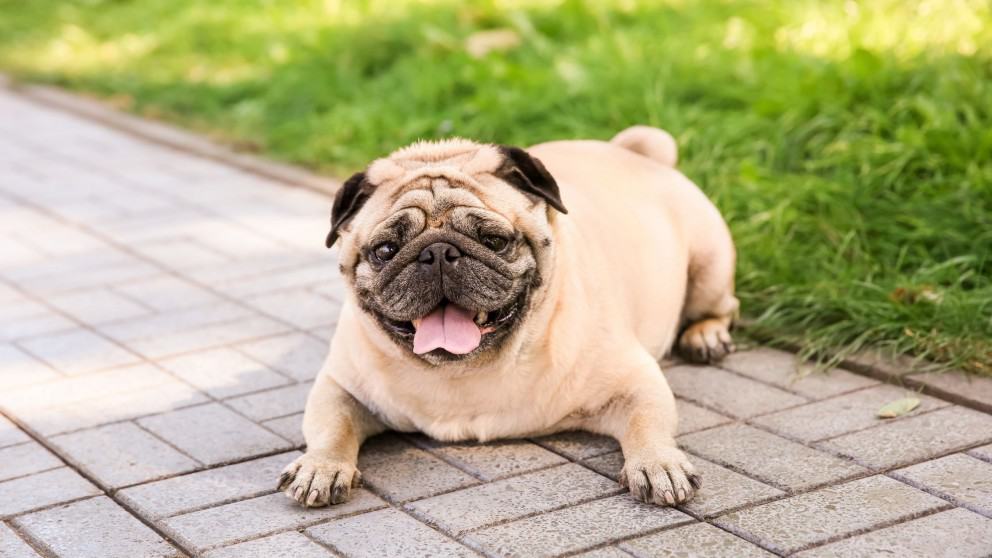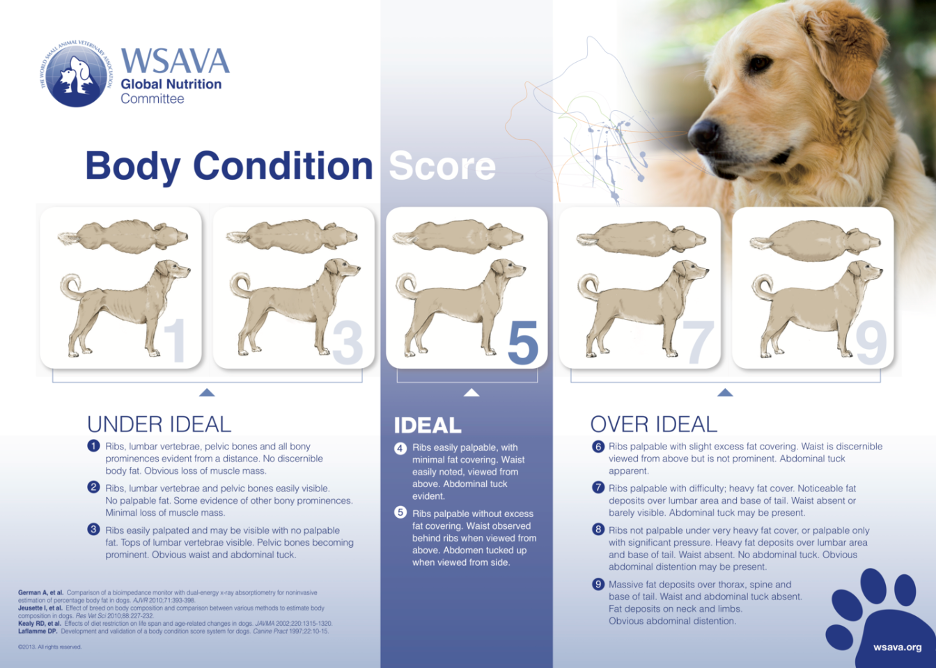The Guide to Weight Loss Supplements for Dogs

An October 2018 clinical study by the American Pet Products Association (APPA) discovered that nearly 50 million dogs in the United States are considered overweight or obese. 36.9% of dogs were classified as overweight, and 18.9% were classified as obese. If your dog looks more rounded or seems sluggish during basic activities such as walking or climbing the stairs, your dog may be overweight or obese.
Just like for us humans, weight loss for dogs can help improve your pet’s quality of life and reduce their risk of weight-related problems like cancer, heart disease, and hypertension. Read on to learn more about weight loss for dogs, including tips for weighing your furry family member and how to help your dog lose weight through healthy diet and exercise choices.
Tips for Weighing Your Dog
But how does one know if his or her dog is carrying excess weight? After all, the first step in how to help your dog lose weight is to understand if he or she is carrying extra pounds.
There are two simple, at-home tests you can do to figure out if your dog is considered overweight:
1) Weigh them on a scale.
First, step on the scale by yourself and note how much you weigh. Then pick up your dog and step back onto the scale. Calculate the difference between your weight and the weight while holding your dog. The difference will be how much your dog weighs. You can use that number to check if they are below or over the breed average. Of course, this method can be difficult if you have a large and/or squirmy pup.
2) Calculate their Body Condition Score (BCS).
Use the BCS chart to determine where your dog is on a scale between 1-9. The ideal score is 5. Anything under 5 is considered under-ideal or underweight; anything over 5 is considered over-ideal or overweight.
Rechecking your dog’s weight on a consistent basis will help you and your family prevent pet obesity and ensure your dog is maintaining their target weight. If, after these tests, you’ve determined your dog to be underweight or overweight, then it’s time to put them on a weight gain or weight loss program. If you’re unsure of your pet’s weight history, make sure to talk with your veterinarian and look back at your pet’s past health records if available.

How Should I Begin Encouraging Weight Loss for Dogs?
As with any weight loss for dogs program, speaking with your dog’s vet is important to strategize the safest way to shed excess weight. Your vet will be able to map out a nutritional program and advise on any needed weight loss supplements for dogs. They will also provide you with your dog’s recommended daily exercise to reach their target weight.
Most dog weight loss programs will begin with a calorie-restrictive diet. This just means you will need to reduce and measure the amount of food you feed your pup daily. A great tip is to purchase a dedicated measuring cup for your dog’s food because it can be easy to unintentionally overfeed your pup throughout the day without them. Mark the number of cups or ounces on the cup with a Sharpie, so you can visually verify you are feeding your dog the right amount. Just remember that amount will likely include any additional treats or supplements.
Usually, calorie restriction will help your dog reach their ideal weight. However, your vet may recommend weight-loss-specific dog food. Diet dog food is different in that it will have the following:
- More Protein
- Less fat
- Fewer calories
Some of the best foods for weight loss for dogs can be found at Dog Food Advisor.
Are dog weight loss supplements or pills safe?
Obese Dogs Diet Pills
There are a number of weight loss supplements for dogs and obese dog diet pills on the market today that promise to help your pet shed pounds fast. However, a calorie-restrictive diet is still the most effective and safest option when it comes to weight loss for dogs. A weight loss supplement or pill may seem like an easier solution, but there is still little research surrounding the long-term safety for dogs, including Dirlotapide and Chitosan. For example, the manufacturer discontinued one of the most popular Dirlotapide supplements, Slentrol, after giving dogs a list of unpleasant side effects, including vomiting, diarrhea, lethargy, anorexia, constipation, and dehydration. A simple diet and exercise program is the best way to help your dog reach their ideal weight, especially because you can tailor this weight-loss plan to your pet’s breed, age, abilities, and interests.
Multivitamins
On the other hand, more natural supplements such as a multivitamin can maintain your dog’s bone, skin, and joint health. Many store-bought pet foods don’t provide the full array of immune-boosting vitamins. In some cases, your vet may recommend a daily multivitamin to strengthen your dog’s overall health. Typically, this would include vitamins A, B12, D3, E, and omega-3.
Regarding weight loss for dogs, utilizing multivitamins can help further improve their overall health over time.
Natural Oils
Speaking of omega-3, studies have shown that coconut oil and fish oils rich in omega-3 and omega-6 fatty acids have been shown to promote weight loss for dogs. They can help with a healthy immune system and have wonderful inflammatory properties that will help with heart health and digestion.
Probiotics
Probiotic chews are another great way to help balance your dog’s gut’s good and bad bacteria. Your pup’s gastrointestinal health can affect its immune system, which rules its energy levels and digestive system. A daily probiotic can help keep their gut in optimal condition and therefore help them be more active and maintain a healthy weight.

Solutions to Common Dog Weight-Loss Problems
In some cases, your dog’s weight loss journey may hit a plateau or even backtrack. Don’t worry. Proper weight management is a long-term process and takes a lot of patience. Here are 7 common solutions to issues you may face when it comes to weight loss for dogs:
Check the feeding amount.
We’re human and can make mistakes. It could be as simple as marking the wrong portion size on a measuring cup to mishearing 1.5 cups vs. 1 cup. Weight loss for dogs comes down to a calorie deficit, so it’s important to ensure you’re feeding your pup the right amount of food to keep them energized!
Look into a higher-quality food option.
Many processed dog kibbles are filled with carb-heavy fillers, leaving dogs feeling less than satisfied and sluggish. Look for fresh foods that are high in protein and low in carbohydrates. We are big believers in feeding our dog’s real food, not kibble. Not only does it satisfy our dogs, but we’ve noticed they don’t beg at the dinner table nearly as often, which benefits their weight loss journey.
Cut back on treats.
Remember earlier when we mentioned that treats are to be included in your dog’s daily feeding amount? Feeding your dog extra treats, especially calorie-heavy ones, can sabotage your dog’s weight loss progress. It can be easy to give extra nibbles to those sweet eyes but remember it’s to keep them healthy and thriving longer.
Of course, treats aren’t always detrimental to weight loss for dogs. It’s all about giving them in moderation and switching to healthier alternatives where available.
Be sure everyone in your household is following the rules.
All it takes is one person to break the cycle. Even if you are following your dog’s diet plan to a T, having a loved one secretly feed your dog scraps under the table is only going to make your dog hungrier. Not only does this halt your pup’s weight loss progress, but it can also leave you feeling extremely frustrated. Make sure everyone is on the same page about your pet’s health before starting with your dog’s weight loss journey.
Provide plenty of water.
Make sure your dog is properly hydrated, especially during warmer months. Having plenty of water readily available to them will help your dog feel fuller, longer and give them the energy to be active.
Increase daily exercise.
If your dog is a larger breed, they probably need more than the recommended 30 minutes of daily exercise. Talk to your vet about slowly introducing longer intervals or more vigorous forms of exercise, such as jogging or hiking, to your dog’s daily routine.
Just like for humans, weight loss for dogs should also include a healthy exercise routine to see the fastest and most long-lasting effects.
Rule out any medical conditions.
If your dog is still not losing weight after following a specific dog weight loss diet and providing adequate exercise, it’s time to visit the vet to rule out any medical conditions. Older dogs especially can suffer from hypothyroidism and Cushing’s disease, which can cause weight gain even with a healthy diet and exercise plan.
How Can I Get My Dog to Lose More Weight Through Exercise?
Just like humans, dogs can also lose weight through exercise. As mentioned earlier, dogs need a minimum of 30 minutes a day of physical exercise, which can be accomplished through walking, jogging, hiking, swimming, and even playing fetch. Your vet can easily help you plan out a daily dog exercise program to help them reach their ideal weight. If your dog is already somewhat active or is a larger breed, the vet may recommend longer intervals or more vigorous activity such as agility training or uphill running.
A weight loss plan for dogs will start to slow and begin to increase in length over time. In some cases, older or less active dogs may only start with 10 minutes a day and slowly increase to 15, 20, then 30 minutes a day. It’s important to be patient and know this is a lifestyle, not a quick fix. Even the smallest daily changes can mean large improvements in your dog’s overall health.
Weight loss for dogs is a marathon, not a sprint. It’s important to be patient with your pet as they get used to a new food and exercise routine and keep encouraging them throughout the process. Who knows, a better routine for your pet can also be beneficial for your health as well!
Help your dog beyond just weight loss with the right pet coverage, even supplemental benefits that you might need. Keep your pup happy and healthy throughout his or her lifetime. Receive a quote for pet coverage today!
Planning to get insurance for your fur babies? This article provides a guide to understanding pet insurance.
